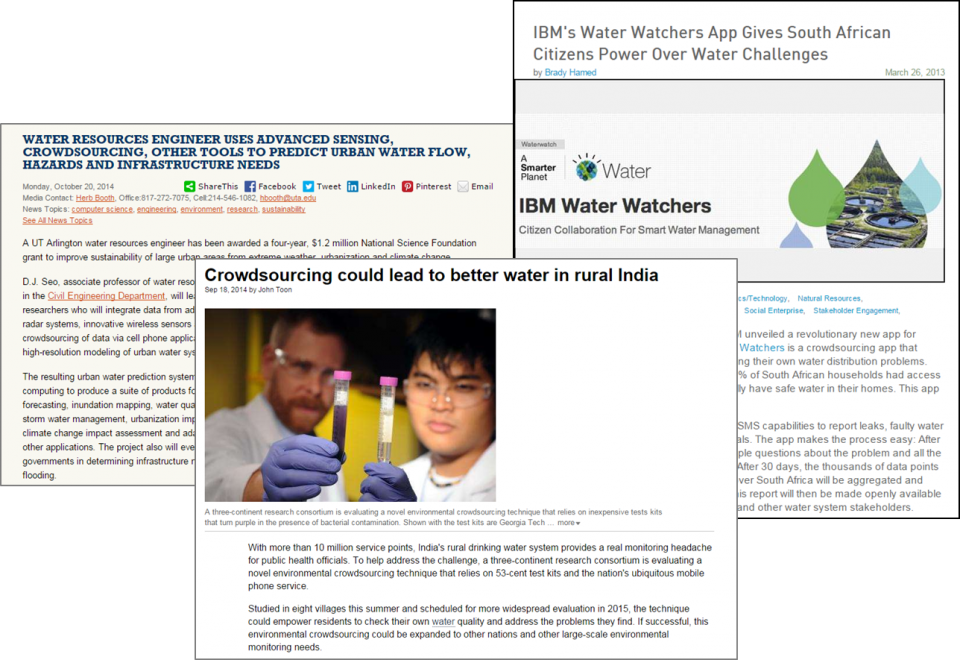Mobile Platforms / Crowdsourcing
Author: Arnold Nagy, Central European University (Budapest, Hungary)
It is no secret that mobile platforms have been at the forefront of technological innovation throughout the last decade, and their importance / market share is only projected to increase further. Smartphone shipments have exceeded those of desktop computers. The rapidly growing capabilities (sensors, hardware, software, social networking) of smartphones and tablets, coupled with their portability and accessibility, make them one of the most impactful ICTs in the world today. In fact, most functionality provided by ICTs previously described is already offered, in some form, on mobile platforms:
- Data portals: mobile devices can access most data portals the same way as other networked computer technologies. Through the same networking functionality, however, mobile platforms become data portals on their own: from applications making use of smartphone sensors to read water gauges, to crowdsourcing-based flood risk management, mobile platforms represent an incredibly potent and continuously expanding data portal capability.

Examples of commercially available sensors for smartphones
- GIS: from the early beginnings of basic mapping functionality and battery-draining, slow GPS capability, mobile devices are today capable of running powerful GIS applications. Similarly to data portals, mobile platforms are more than just geospatial data ‘consumers’. Citizen reporting functionalities, for example, do not require highly accurate location data and provide valuable input to geospatial databases/services; novel applications are constantly launched, in line with the growing number of users/devices involved.
- Remote sensing: A number of multi-function sensors have already been developed for mobile devices. More are expected to be launched soon. These modules can include interchangeable sensors for gases, wind speed, humidity, temperature, barometric pressure and radiation. Within the same context of crowdsourcing, there is a considerable number of potential applications by networking information from a large number of devices.
- Data analysis: The capabilities of mobile devices to perform data analysis, including modelling, simulation and optimization using big-data, are only limited by their hardware/software. Given the rate of development in their computational performance, and especially the strong trend towards using mobile devices within a cloud computing environment, their use for data analysis is likely to continue to grow.
- Distance learning: Mobile devices are ideal distance learning terminals. Furthermore, as preferred platforms for social networking, they provide a natural transition to communication tools typically available in virtual classrooms.
- Decision support systems: judging from current trends, the DSS systems of the future are likely to be cloud-based and accessible via Internet. This potentially endows every smartphone or tablet with a DSS capability comparable to that of any other ICT interface.

One of the most exciting developments made possible by the rapid spread of mobile technology is crowdsourcing. By engaging citizen scientists in spatially and temporally distributed measurements of processes, a significant yet inexpensive stream of useful information can be generated.
The ubiquity of mobile phones means that mobile technology and instrumentation is available for data collection and transmission in areas where traditional monitoring infrastructure might be insufficient or lacking (e.g. developing countries, rural areas). By popularizing simple tools and applications allowing the collection and transmission of water data (e.g. water quality, water levels, storm water), as well as the opinions and ideas of the users, crowdsourcing can both generate highly valuable stream data, and foster a participatory approach in water resource management.
There is clear and accelerated progress in the application of mobile technologies in support of crowdsourcing. On one hand, as technology continues to evolve, more and more sophisticated instrumentation will be made available in portable devices, including mobile phones. On the other hand, an increasing focus on refining user-experience and exploring new possibilities for citizen-science using mobile technologies (Figure 3) is likely to quickly expand their contribution to the challenging task of managing the world’s water resources.

Crowdsourcing projects for water management making use of mobile technologies
_
